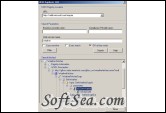|
UDDI Explorer 
|
Tool for searching web service(s) and viewing their WSDL information. UDDI Explorer is a tool for searching web service(s) and viewing their WSDL information.
Web services are still new and growing up, it will definitely have an important role to play in the future of distributed computation. In this paper, I introduce a tool that allows you to search web services via UDDI registry servers. The point of my tool is to deliver business value, which in this case means easy discovery of web services and letting you view their WSDL on a tree.
Prior to making this tool, I fumbled through MSDN and CodeProject, to learn about how to discover a web service from UDDI, parsing a WSDL and XML schema. Along with some of my previous works on text processing, the program was born with the following features:
1. Discover web services via UDDI server.
2. N-grams TF-IDF based post-filtering.
3. Parsing the Web Service Description Information (WSDL) and displaying them onto a hierarchical tree.
A UDDI server is a web services registry, it contains the following information:
- Business and other service providers.
- Services they will expose.
- Binding information (locations) of those services.
- Interfaces supported by those services.
Looking at the UDDI mechanism we find that it is a web service, which exposes information about other web services.
Before going further, you should have a basic understanding of WSDL, XML namespaces and XML schema. WSDL is a document written in XML. It provides a way for service providers to describe the basic format of web service requests over different protocols. The WSDL specification defines the following major elements of networked XML-based services:
1. Types provides data type definitions used to describe the messages exchanged.
2. Message represents an abstract definition of the data being transmitted or communicated.
3. Operation is an abstract description of an action supported by the service. Each operation refers to an input message and output message.
4. Port Type is a set of operations supported by one or more endpoints.
5. Binding specifies concrete protocol and data format specification for the operations and messages defined by a particular port type.
6. Port specifies an address for a binding or the URL where the web service is listening.
7. Service is a collection of related ports.
Typically, information common to a certain category of business services such as message formats, port types, and protocol bindings, are included in the reusable portion, while information pertaining to a particular service endpoint is included in the service implementation definition portion.
A UDDI server is a web services registry, it contains the following information:
1. Business and other service providers.
2. Services they will expose.
3. Binding information (locations) of those services.
4. Interfaces supported by those services.
Looking at the UDDI mechanism we find that it is a web service, which exposes information about other web services.
The license of this software is Free, you can free download and free use this server utility software.
